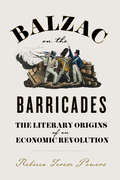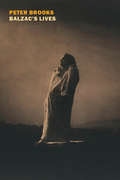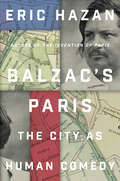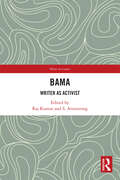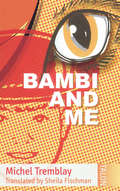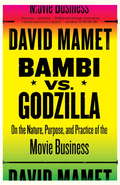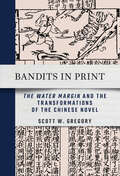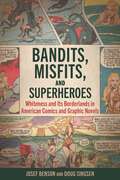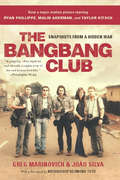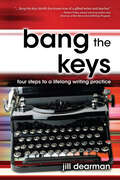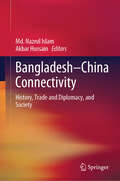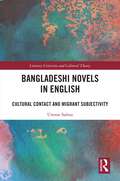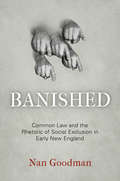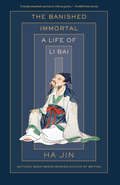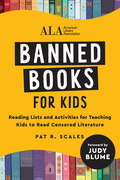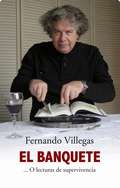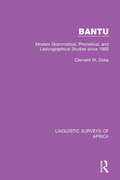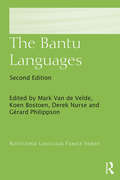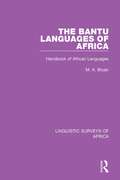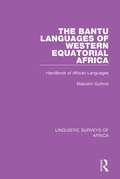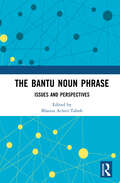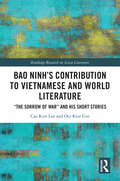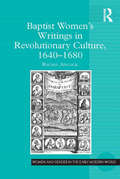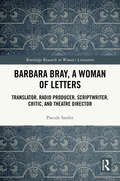- Table View
- List View
Balzac on the Barricades: The Literary Origins of an Economic Revolution
by Rebecca Terese PowersThe role of nineteenth-century French literature in a distinctively modern political movement When Parisian workers took to the streets in February 1848, they adopted the rallying cry of droit au travail (the right to work). That protesters increasingly framed employment as a political right represented a radical and modern development. But where had this idea originated? In her examination of this cause célèbre of France&’s Second Republic, Rebecca Powers shows that the redefinition of labor as a basic right sprang not only from political debates but also directly from contemporary literature. Powers charts the rise of this revolutionary concept through the tales of bourgeois dominance in the novels and newspaper articles of Honoré de Balzac. As Powers explains, this realist semiotician of French provincial and urban life par excellence was the first to attempt a definition of modern labor as an integral part of the emerging modern society. Powers makes clear how recognizing Balzac&’s influence on mid-nineteenth-century political discourse is essential to understanding the course of events in that earth-shaking year.
Balzac's Lives
by Peter BrooksEnter the mind of French literary giant Honoré de Balzac through a study of nine of his greatest characters and the novels they inhabit. Balzac's Lives illuminates the writer's life, era, and work in a completely original way.Balzac, more than anyone, invented the nineteenth-century novel, and Oscar Wilde went so far as to say that Balzac had invented the nineteenth century. But it was above all through the wonderful, unforgettable, extravagant characters that Balzac dreamed up and made flesh—entrepreneurs, bankers, inventors, industrialists, poets, artists, bohemians of both sexes, journalists, aristocrats, politicians, prostitutes—that he brought to life the dynamic forces of an era that ushered in our own. Peter Brooks&’s Balzac&’s Lives is a vivid and searching portrait of a great novelist as revealed through the fictional lives he imagined.
Balzac's Paris: The City as Human Comedy
by Eric HazanExploring Paris arm in arm with Balzac, nineteenth-century France&’s most famous novelist and observerIn Balzac&’s vast Human Comedy, a body of ninety-one completed novels and stories, he endeavoured to create a complete picture of contemporary French society and manners. Within this work is a loving ode to Paris and an incomparable introduction to the first capital of the modern world.To this ageless city he makes a declaration of love in an accumulation of finely observed detail – the cafés, landmarks, avenues, parks – and captures the populace in countless meticulously drawn portraits: its lawyers, grisettes, journalists, concierges, usurers, salesmen, speculators.Balzac gathered the elements of this Paris by sauntering through it. &‘To saunter is a science,&’ he writes, &‘it is the gastronomy of the eye. To take a walk is to vegetate; to saunter is to live.&’ Eric Hazan follows in Balzac&’s footsteps, criss-crossing the city in the novelist&’s outsize boots, running between printers, publishers, coffee merchants, mistresses and friends, stopping for a moment, struck by a detail that would be fixed in Balzac&’s photographic memory.More than a tour of the city, Balzac&’s Paris is an attempt to measure the soul of a city as recovered in its finest literature.
Bama: Writer as Activist (Writer in Context)
by Raj Kumar and S. ArmstrongBama is a Tamil Dalit feminist writer and novelist. Her autobiographical novel Karukku, which chronicles the joys and sorrows experienced by Dalit Christians in Tamil Nadu, catapulted her to fame. As a prolific writer, she has experimented with all kinds of genres, such as novels, short stories, poems, autobiographical writing, children’s literature, and discursive essays. This book presents a dedicated study of Bama’s work as a writer and activist and situates her in the context of Dalit literature in general and Tamil Dalit literature in particular. It recognises Bama as writer of great relevance especially in bringing to the fore the problematics of Dalit issues and their possible modes of aesthetic articulation through a new Dalit language.Part of the Writer in Context series, this book will be useful for scholars and researchers of Indian literature, Dalit Literature, Dalit Studies, Tamil literature, English literature, comparative literature, postcolonial studies, cultural studies, Green studies. global south studies and translation studies.
Bambi and Me
by Michel TremblayBambi and Me consists of twelve autobiographical pieces about how movies shaped the young life of Michel Tremblay, one of their biggest fans. Among others, he talks about Twenty Thousand Leagues Under the Sea, Cinderella, Snow White and the Seven Dwarves, Parade of the Wooden Soldiers, Orphée and The Night Visitors, and about how each led to his discovery of his emerging emotional sensibilities as a child and an adolescent. In the piece that gives the book its title, he writes: "Did you cry as much as I did at the death of Bambi's mother? Personally, I've never got over it." Bursting with wit, charm, and the profound resonance of youthful self-discovery, Bambi and Me provides Tremblay's many fans with a clear sense of the origins of the talent which has made Michel Tremblay one of the most important and fascinating playwrights and novelists of the twentieth century.
Bambi vs. Godzilla: On The Nature, Purpose, and Practice of the Movie Business
by David MametInBambi vs. Godzilla, David Mamet, the award-winning playwright and screenwriter, gives us an exhilaratingly subversive inside look at Hollywood from the perspective of a filmmaker who has always played the game his own way. Who really reads the scripts at the film studios? How is a screenplay like a personals ad? Whose opinion matters when revising a screenplay? Why are there so many producers listed in movie credits? And what the hell do those producers do, anyway? Refreshingly unafraid to offend, Mamet provides hilarious, surprising, and bracingly forthright answers to these and other questions about virtually every aspect of filmmaking, from concept to script to screen. He covers topics ranging from “How Scripts Got So Bad” to the oxymoron of “Manners in Hollywood. ” He takes us step-by-step through some of his favorite movie stunts and directorial tricks, and demonstrates that it is craft and crew, not stars and producers, that make great films. He tells us who his favorite actors and what his favorite movies are, who he thinks is the most perfect actor to grace the screen, and who he thinks should never have appeared there. Demigods and sacred cows of the movie business–beware! But for the rest of us, Mamet speaking truth to Hollywood makes for searingly enjoyable reading. From the Hardcover edition.
Bananas - Reader
by Carrie TothThis compelling, culture-packed, historical Comprehension-based reader is inspired by real events and the real life of 'Marito'. With 275 high-frequency unique words, it is an ideal read for intermediate Spanish students.
Bandits in Print: "The Water Margin" and the Transformations of the Chinese Novel
by Scott W. GregoryBandits in Print examines the world of print in early modern China, focusing on the classic novel The Water Margin (Shuihu zhuan). Depending on which edition a reader happened upon, The Water Margin could offer vastly different experiences, a characteristic of the early modern Chinese novel genre and the shifting print culture of the era.Scott W. Gregory argues that the traditional novel is best understood as a phenomenon of print. He traces the ways in which this particularly influential novel was adapted and altered in the early modern era as it crossed the boundaries of elite and popular, private and commercial, and civil and martial. Moving away from ultimately unanswerable questions about authorship and urtext, Gregory turns instead to the editor-publishers who shaped the novel by crafting their own print editions. By examining the novel in its various incarnations, Bandits in Print shows that print is not only a stabilizing force on literary texts; in particular circumstances and with particular genres, the print medium can be an agent of textual change.
Bandits, Misfits, and Superheroes: Whiteness and Its Borderlands in American Comics and Graphic Novels
by Josef Benson William SingsenShortlisted Finalist for the 2023 Eisner Award for Best Academic/Scholarly WorkAmerican comics from the start have reflected the white supremacist culture out of which they arose. Superheroes and comic books in general are products of whiteness, and both signal and hide its presence. Even when comics creators and publishers sought to advance an antiracist agenda, their attempts were often undermined by a lack of awareness of their own whiteness and the ideological baggage that goes along with it. Even the most celebrated figures of the industry, such as Jerry Siegel and Joe Shuster, Jack Jackson, William Gaines, Stan Lee, Robert Crumb, Will Eisner, and Frank Miller, have not been able to distance themselves from the problematic racism embedded in their narratives despite their intentions or explanations.Bandits, Misfits, and Superheroes: Whiteness and Its Borderlands in American Comics and Graphic Novels provides a sober assessment of these creators and their role in perpetuating racism throughout the history of comics. Josef Benson and Doug Singsen identify how whiteness has been defined, transformed, and occasionally undermined over the course of eighty years in comics and in many genres, including westerns, horror, crime, funny animal, underground comix, autobiography, literary fiction, and historical fiction. This exciting and groundbreaking book assesses industry giants, highlights some of the most important episodes in American comic book history, and demonstrates how they relate to one another and form a larger pattern, in unexpected and surprising ways.
The Bang-Bang Club: Snapshots From a Hidden War
by Greg Marinovich Joao Silva Archbishop Desmond TutuA gripping story of four remarkable young men—photographers, friends and rivals—who band together for protection in the final, violent days of white rule in South Africa.
Bang The Keys: Four Steps to a Lifelong Writing Practice
by Jill DearmanAttention aspiring and working writers alike! Finish your work in four easy steps with this explosion of inspiration. How can aspiring writers-whether aiming for a short story, novel, screenplay, or nonfiction work-gain the confidence they need to follow through on their creative visions.... The answer can be found in this book by a writing coach and university writing professor whose "Bang the Keys" workshop stems from an innovative four-step system that offers practical advice for demonstrated results every time. Step 1: Begin with the strongest idea. Step 2: Arrange the work into a concrete shape. Step 3: Nurture the project with love, so that others can love it, too. Step 4: Go finish, and then let it go so it may live independently in the world. Also included are practical writing exercises that will give readers the tools and the inspiration to finish the writing projects they start ... or bust their fingers trying!
Bangladesh–China Connectivity: History, Trade and Diplomacy, and Society
by Md. Nazrul Islam Akbar HussainThis book adopts an interdisciplinary social science approach. It includes original research papers on Bangladesh-China’s connectivity to archaeology, history, religion, traditional Chinese medicine, language and literature, women and gender, diplomacy and strategic relations, bilateral business and trade, and the Belt and Road Initiative (BRI). Most of the existing literature perceives bilateral and regional connectivity from economic and strategic points of view and emphasizes financial and political profit-loss and integration. This book combines the archeological and cultural issues from history and diplomacy, and soft power from the present. The content of this book has a broader scope and is divided into six parts including background and introduction; archeology, history, and religion; business and trade; diplomacy and geo-strategy; traditional Chinese medicine; language and literature; and society, culture, and gender. This book is particularly designed for undergraduate and postgraduate students, researchers, academics, journalists, and strategic think tanks from broader humanities and social sciences backgrounds including, history, archeology, religious studies, philosophy, sociology, anthropology, political sciences, international relations, economics, environmental studies, language and literary studies, gender studies, health studies, and business.
Bangladeshi Novels in English: Cultural Contact and Migrant Subjectivity (Literary Criticism and Cultural Theory)
by Umme SalmaBangladeshi Novels in English: Cultural Contact and Migrant Subjectivity is the first comprehensive study of Bangladeshi migration and diasporas through eight seminal Bangladeshi novels in English from the late twentieth and twenty-first centuries: Adib Khan’s Seasonal Adjustments and Spiral Road, Farhana H. Rahman’s The Eye of the Heart, Monica Ali’s Brick Lane, Manzu Islam’s Burrow, Nashid Kamal’s The Glass Bangles, Zia H. Rahman’s In the Light of What We Know, and Tahmima Anam’s The Bones of Grace. The book situates the study within the English-language literary history and linguistic ethnography of Bangladesh while unveiling the complexities of Bangladeshi Muslim migration from men, women, and children’s perspectives. It challenges the stereotyping of Bengali Muslim migrants as a failure of immigration and multiculturalism and offers a fresh view on cultural contact and the formation of migrant subjectivity at the intersections of gender, race, religion, class, culture, ethnicity, history, politics, and personality.
Banished
by Nan GoodmanA community is defined not only by inclusion but also by exclusion. Seventeenth-century New England Puritans, themselves exiled from one society, ruthlessly invoked the law of banishment from another: over time, hundreds of people were forcibly excluded from this developing but sparsely settled colony. Nan Goodman suggests that the methods of banishment rivaled--even overpowered--contractual and constitutional methods of inclusion as the means of defining people and place. The law and rhetoric that enacted the exclusion of certain parties, she contends, had the inverse effect of strengthening the connections and collective identity of those that remained.Banished investigates the practices of social exclusion and its implications through the lens of the period's common law. For Goodman, common law is a site of negotiation where the concepts of community and territory are more fluid and elastic than has previously been assumed for Puritan society. Her legal history brings fresh insight to well-known as well as more obscure banishment cases, including those of Anne Hutchinson, Roger Williams, Thomas Morton, the Quakers, and the Indians banished to Deer Island during King Philip's War. Many of these cases were driven less by the religious violations that may have triggered them than by the establishment of rules for membership in a civil society. Law provided a language for the Puritans to know and say who they were--and who they were not. Banished reveals the Puritans' previously neglected investment in the legal rhetoric that continues to shape our understanding of borders, boundaries, and social exclusion.
The Banished Immortal: A Life of Li Bai (Li Po)
by Ha JinFrom the National Book Award-winning author of Waiting: a narratively driven, deeply human biography of the Tang dynasty poet Li Bai—also known as Li PoIn his own time (701–762), Li Bai's poems—shaped by Daoist thought and characterized by their passion, romance, and lust for life—were never given their proper due by the official literary gatekeepers. Nonetheless, his lines rang out on the lips of court entertainers, tavern singers, soldiers, and writers throughout the Tang dynasty, and his deep desire for a higher, more perfect world gave rise to his nickname, the Banished Immortal. Today, Bai's verses are still taught to China's schoolchildren and recited at parties and toasts; they remain an inextricable part of the Chinese language.With the instincts of a master novelist, Ha Jin draws on a wide range of historical and literary sources to weave the great poet's life story. He follows Bai from his origins on the western frontier to his ramblings travels as a young man, which were filled with filled with striving but also with merry abandon, as he raised cups of wine with friends and fellow poets. Ha Jin also takes us through the poet's later years—in which he became swept up in a military rebellion that altered the course of China's history—and the mysterious circumstances of his death, which are surrounded by legend.The Banished Immortal is an extraordinary portrait of a poet who both transcended his time and was shaped by it, and whose ability to live, love, and mourn without reservation produced some of the most enduring verses.
Banned Books for Kids: Reading Lists and Activities for Teaching Kids to Read Censored Literature
by American Library Association (ALA)From the American Library Association comes an expansive guide to teaching banned books to children at home or in the classroom, with a forward by renowned children's author Judy Blume.Books matter. In our polarized environment, the censorship and outright banning of children's books remains a major concern for libraries. The American Library Association, an intellectual freedom champion, has created this illuminating and expansive guide for book lovers who hope to teach children the importance of banned literature. With a focus on modern books that have been banned, along with classic literature that continues to be under attack for political or religious reasons, Teaching Banned Books to Kids will educate adults and children about the importance of books. With useful tools and techniques, caregivers and educators will find the best ways to talk about banned books to children.
El Banquete: ....O lecturas de supervivencias
by Fernando Villegas DarrouyDesde El Quijote a Hamlet, pasando por las crónicas de su admirado Joaquín Edwards Bello y las novelas de terror de Stephen King, el autor nos acerca a diversos libros a través de un ejercicio libre, espontáneo y «al reverendo lote» -según confiesa-, en el que «divaga a destajo y sin vergüenza» sobre algunos de sus platillos de papel favoritos. De manera que saltaremos de Antonio Skármeta a Ray Bradbury, de Moby Dick a Fausto, del genio de Nicanor Parra a la maestría de Marguerite Yourcenar, en una invitación sui generis con valiosas recomendaciones para la supervivencia espiritual inspirada en el puro y digno placer por la lectura. Desde El Quijote a Hamlet, pasando por las crónicas de su admirado Joaquín Edwards Bello y las novelas de terror de Stephen King, el autor nos acerca a diversos libros a través de un ejercicio libre, espontáneo y «al reverendo lote» -según confiesa-, en el que «divaga a destajo y sin vergüenza» sobre algunos de sus platillos de papel favoritos. De manera que saltaremos de Antonio Skármeta a Ray Bradbury, de Moby Dick a Fausto, del genio de Nicanor Parra a la maestría de Marguerite Yourcenar, en una invitación sui generis con valiosas recomendaciones para la supervivencia espiritual inspirada en el puro y digno placer por la lectura.
Bantu: Modern Grammatical, Phonetical and Lexicographical Studies Since 1860 (Linguistic Surveys of Africa #10)
by Clement M. DokeOriginally published in 1945, this volume represented the first to classify Bantu languages. This volume does not record all the dialects but makes reference to those in which some grammatical study has been done and classifies them according to mainly geographical zones. Owing to tribal migrations, individual members of a particular zone may be living among members of a different zone (as has been the case with the Ngoni, South-Eastern Zone, who are found among the Eastern Bantu), but the zone label is taken from the habitat of the majority.
The Bantu Languages (Routledge Language Family Series)
by Mark Van De Velde Koen Bostoen Derek Nurse Gérard PhilippsonWritten by an international team of experts, this comprehensive volume presents grammatical analyses of individual Bantu languages, comparative studies of their main phonetic, phonological and grammatical characteristics and overview chapters on their history and classification. It is estimated that some 300 to 350 million people, or one in three Africans, are Bantu speakers. Van de Velde and Bostoen bring together their linguistic expertise to produce a volume that builds on Nurse and Philippson’s first edition. The Bantu Languages, 2nd edition is divided into two parts; Part 1 contains 11 comparative chapters, and Part 2 provides grammar sketches of 12 individual Bantu languages, some of which were previously undescribed. The grammar sketches follow a general template that allows for easy comparison. Thoroughly revised and updated to include more language descriptions and the latest comparative insights. New to this edition: • new chapters on syntax, tone, reconstruction and language contact • 12 new sketch grammars • thoroughly updated chapters on phonetics, aspect-tense-mood and classification • exhaustive catalogue of known languages with essential references This unique resource remains the ideal reference for advanced undergraduate and postgraduate students of Bantu linguistics and languages. It will be of interest to researchers and anyone with an interest in historical linguistics, linguistic typology and grammatical analysis.
The Bantu Languages of Africa: Handbook of African Languages (Linguistic Surveys of Africa #17)
by M. A. BryanThe area covered by this book, originally published in 1953, is one that has long been recognized as presenting many problems from the point of view of Bantu linguistic studies. Almost all the material set out in this present work is based on notes taken in the field, and in many cases presented completely new facts. The sources of the information used are listed at the end of the linguistic description of each of the groups of languages dealt with. Since there are so many languages to be covered it would be impracticable to give even an outline of the main features of each of them, so an outline is given of the main characteristics of each separate group. One language is used as the type for each group, for the purpose of listing examples of the nominal prefixes, verbal conjugation, and personal prefixes. Other features are illustrated from whichever language is the most suitable.
The Bantu Languages of Western Equatorial Africa: Handbook of African Languages (Linguistic Surveys of Africa #16)
by Malcolm GuthrieThe area covered by this book, originally published in 1953, is one that has long been recognized as presenting many problems from the point of view of Bantu linguistic studies. Almost all the material set out in this present work is based on notes taken in the field, and in many cases presented completely new facts. The sources of the information used are listed at the end of the linguistic description of each of the groups of languages dealt with. Since there are so many languages to be covered it would be impracticable to give even an outline of the main features of each of them, so an outline is given of the main characteristics of each separate group. One language is used as the type for each group, for the purpose of listing examples of the nominal prefixes, verbal conjugation, and personal prefixes. Other features are illustrated from whichever language is the most suitable.
The Bantu Noun Phrase: Issues and Perspectives
by Blasius Achiri-TabohThis collection of original essays addresses salient issues in a range of empirical and conceptual analyses, providing detailed case studies of phenomena in Bantu languages and robust and interesting discussions on the structure of the noun phrase. This volume speaks to contemporary debates on the Bantu noun phrase, seeking to stimulate a greater understanding of the true nature of adnominal modification, definiteness, and anaphoric relations associated with it, with respect to various segmental and supra-segmental, noun formation, and noun classification phenomena. The ten chapters take the reader through the Grassfields, North-Western, North-Eastern and Southern present-day Bantu homeland, making important contributions to the documentation and analysis of Bantu languages. The Bantu Noun Phrase: Issues and Perspectives is unique in its inclusion of so many North-Eastern Bantu languages in its discourse on Bantu linguistics and this important collection will be of particular interest to those researching, teaching, and studying African languages and linguistics.
Bao Ninh's Contribution to Vietnamese and World Literature: "The Sorrow of War" and his Short Stories (Routledge Research on Asian Literature)
by Cao Kim Lan Ooi GinBao Ninh's Contribution to Vietnamese and World Literature analyzes and presents the works of Bao Ninh, the most well-known writer in modern Vietnamese literature. His works are renowned both in Vietnam and worldwide and his novel The Sorrow of War, which has been translated into more than 15 languages, is considered to be one of the classic works of war literature.This book by two award-winning scholars, one in war literature and the other in war history, presents for the first time an overall assessment of Bao Ninh’s works, notably of his celebrated novel and his short stories. It outlines his life, setting it in the context of war-torn Vietnam whence he was a teenage soldier at the age of 17 in the North Vietnamese People's Army (NVPA); highlights the main themes of the corpus of his writings, inter alia of suffering and trauma of war impacts of post-traumatic stress disorder (PTSD) of veterans, of the futility of war; discusses his approach to writing; compares his writings with others in war literature; and examines and assesses his especial place in world literature. This pioneering monograph of the scholarly evaluation of Bao Ninh himself and his works further engages in the discourse of his contribution to modern Vietnamese literature and world literature. Encouraging a better understanding of wars and conflicts, the book will be of interest to researchers and students in the fields of modern Asian history, in particular the Vietnam War, Southeast Asian Studies, and Vietnamese and World literature.
Baptist Women’s Writings in Revolutionary Culture, 1640-1680 (Women and Gender in the Early Modern World)
by Rachel AdcockAlthough literary-historical studies have often focused on the range of dissenting religious groups and writers that flourished during the English Revolution, they have rarely had much to say about seventeenth-century Baptists, or, indeed, Baptist women. Baptist Women’s Writings in Revolutionary Culture, 1640-1680 fills that gap, exploring how female Baptists played a crucial role in the group’s formation and growth during the 1640s and 50s, by their active participation in religious and political debate, and their desire to evangelise their followers. The study significantly challenges the idea that women, as members of these congregations, were unable to write with any kind of textual authority because they were often prevented from speaking aloud in church meetings. On the contrary, Adcock shows that Baptist women found their way into print to debate points of church organisation and doctrine, to defend themselves and their congregations, to evangelise others by example and by teaching, and to prophesy, and discusses the rhetorical tactics they utilised in order to demonstrate the value of women’s contributions. In the course of the study, Adcock considers and analyses the writings of little-studied Baptist women, Deborah Huish, Katherine Sutton, and Jane Turner, as well as separatist writers Sara Jones, Susanna Parr, and Anne Venn. She also makes due connection to the more familiar work of Agnes Beaumont, Anna Trapnel, and Anne Wentworth, enabling a reassessment of the significance of those writings by placing them in this wider context. Writings by these female Baptists attracted serious attention, and, as Adcock discusses, some even found a trans-national audience.
Barbara Bray, A Woman of Letters: Translator, Radio Producer, Scriptwriter, Critic, and Theatre Director (Routledge Research in Women's Literature)
by Pascale SardinBarbara Bray (1924-2010) was an English woman of letters who translated some hundred novels, plays, and essays from French to English and was Marguerite Duras’s preferred translator. She also collaborated with some of the most prestigious directors and playwrights of the 20th century – Harold Pinter, Samuel Beckett, Joseph Losey, and Franco Zeffirelli – helping them write screenplays and radioplays. This literary biography (re)evaluates in a textual, sociological, and historical perspective the social role of an English writer and translator in the history of ideas and contemporary art. Highlighting Bray’s influence in cultural transfers of ideas and literatures between France, Great Britain, and the United States, it renders visible the yet unrecognised work of a female mediator and creator. It nourishes the debate about women’s public voice and the representation of women in the media industries and contributes to enrich the ‘other’ history that is being currently written by feminist scholars around the world.
